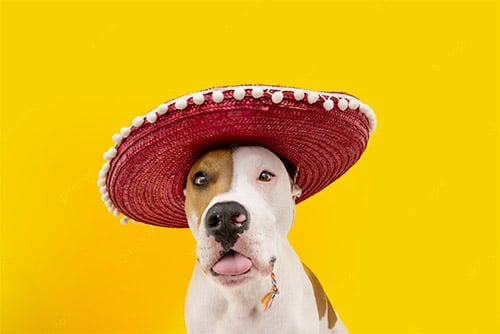In one of the many conversations about nothing on the old sitcom Seinfeld, George brings up “Salsa is now the number one condiment in America.”
His friend Jerry responds “You know why? Because people like to say ‘salsa.'”
But, you don’t want Fido to get in that bowl!
So no, dogs can’t eat salsa because most salsa has ingredients that are toxic to dogs.
Why Salsa Is Bad For Dogs
Though Taco Bell would advertise their products in commercials featuring a Chihuahua named Gidget who would say “Yo quiero Taco Bell,”, your dog no quiero Taco Bell or any Mexican food including salsa.
The reason for this is that even Mexican food toned down for sensitive palates tends to have a good deal of garlic and onions in it.
All parts of all vegetables in the allium family (Onions, garlic, chives, leeks and shallots) are harmful to dogs whether raw, cooked or even dried and powdered.
One medium-sized onion is enough to cause toxic effects in a 20 kilogram (44 pounds) dog.
That tiny Chihuahua wouldn’t stand a chance!

Salsa Ingredients – What’s Safe For Dogs?
What goes into salsa and how much varies from one recipe to another.
There are mild salsas, hot salsas and extra spicy “Don’t say we didn’t warn you” salsas.
Some salsas have bits of fruit like mango or pineapple.
Some have avocados or roasted corn.
For people who like salsa that’s less sweet and more acidic, there’s salsa Verde, made with green tomatillos instead of red tomatoes.
In any case, it’s very flavorful stuff that gives Mexican food its famous kick.
It may be a kick for humans, but for a dog it can make them very sick or even kill them.
Let’s have a quick look at the most common ingredients found in salsas.
- Tomatoes: It is safe to feed your dog red, ripe tomatoes as an occasional snack. They’re a good source of vitamin C, potassium and lycopene compounds. Just remember that a dog should only eat the red part. The leaves and vines are poisonous.
- Onions: As said before, these are not good for your dog at all. Even small amounts of onion powder are sure to give your dog tummy trouble at least. Minced onion is commonly found in Pico de Gallo as well as most salsas and other Mexican and Tex-Mex dishes.
- Garlic:Like everything else in the allium family, garlic is bad for dogs. The health benefits of garlic have been touted as it does indeed help in lowering cholesterol, reducing blood pressure and boosting immunity. However, while great for humans, garlic causes hemolytic anemia in dogs.
- Cilantro: This isn’t so bad. Know how some dogs will nibble grass if they have a tummy ache? Cilantro can also ease an upset stomach as well as deliver a dose of vitamins A and C with zinc and potassium. A little bit sprinkled on dog food or mixed in a treat is fine. A little goes a long way.
- Lime Juice: Lime juice is highly acidic. While it adds a nice bit of tartness to foods, it’s just too much for a dog. It is highly toxic to canines. Even touching the leaves of a lime tree can be poisonous to a dog. Most dogs hate the smell of citrus, so it’s unlikely your dog will even want it anyway.
- Serrano Peppers: A close cousin to the jalapeño, the serrano is twice or even five times as hot. They’re full of vitamin A, if you can take the heat. They might get your blood going, but Fido doesn’t need them. Very spicy peppers are not for your dog. It’s another smell dogs don’t like much either.
- Jalapeño Peppers: A bit of jalapeño, might be mostly harmless. However, a good deal of them can cause stomach ulcers or diarrhea in a dog. Because a dog’s taste buds are arranged differently than a human’s, it may take them a moment to realize what they’re eating is too spicy. Don’t be mean to your dog!
- Amarillo Peppers : It has a bit of a fruity flavor and is somewhere between a jalapeño and a Serrano in heat. Chili peppers in general are not great foods for dogs. The compound that makes peppers spicy is called capsaicin. It can cause serious digestive issues in a dog.
- Salt: Your dog probably gets all the sodium they need if they eat commercial dog food. Extra salt is not at all good for a dog. Too much salt can poison a dog, leading to seizures, dehydration, vomiting and diarrhea. In fact, your dog needs access to fresh water at all times in part to reduce salt taxicity.
Conclusion
One thing salsa and Chihuahuas have in common is both were created by Aztecs, Toltecs and other Central American tribes.
It’s unlikely the Chihuahuas who predated Cortés were fed salsa since it had so many things bad for dogs in it.
More likely, they were fed the leftovers from a successful fishing trip, hunt or human sacrifice.
Today, a salsa made with fresh vegetables is not only a very tasty appetizer but it’s healthy as well.
For humans, that is.
Ripe red tomatoes and sweet peppers are healthy treats, if your dog likes them.
Onions, garlic, hot peppers, lime juice and extra salt are all things you need to cut out of Fido’s diet.
Because most dogs don’t like how peppers smell, you might not have to worry about your pup eating much. Keep it out of his reach anyway.
